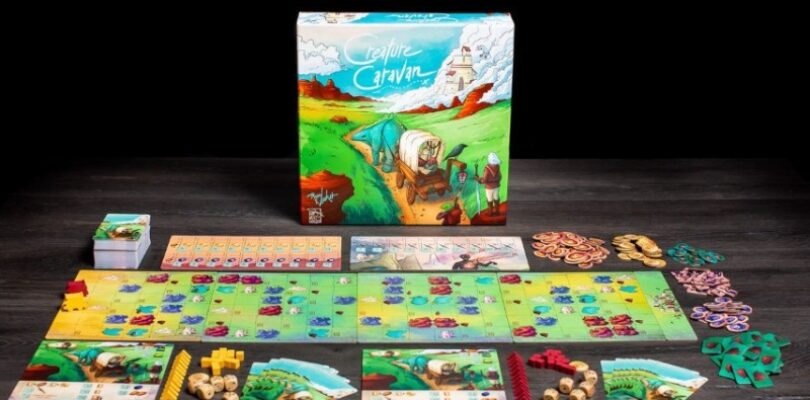Listen to this article
Ryan Laukat has built a dedicated fan base for his games set in the world of Arzium, including Above and Below, Near and Far, Now or Never, Islebound, and my favorite of the group, the light but sneaky-good game Roam. Most of his games are in the 90+ minute range to play and are aimed at folks who’ve played some Eurogames before. His latest work, Creature Caravan, manages to maintain the spirit of some of his heavier designs, but it’s much shorter to play and a lot easier to get into as well.
Creature Caravan is a dice-placement game: each player has five dice, rolls them on every turn, and then places them on various spots on their player boards or on the cards they play as the game progresses. You’re also dealing with some resource management, building a tableau of cards, moving your caravan across the map, and fighting zombies (they’re pretty harmless, though), but the real heart of the game is the dice—managing them and placing them to maximize your 12 turns across the length of one play.
Each player has a caravan token that starts on the leftmost side of the horizontal, modular board, which has a grid of spaces six rows high; each space has its own terrain type, some of which show a reward you get for ending your turn there while some indicate that the space is haunted, spawning a zombie that goes to your player board. One of your goals in the game is to advance your caravan as far as you can across the board, moving left to right, with the maximum point total coming if you reach the town of Eastrey at the rightmost end.
At the start of each turn, all players roll their five dice and then place them simultaneously—so the game length doesn’t vary much by player count. Each player’s starting board has nine spots for the dice, most of which require the die placed there to meet or exceed a specific value. When you place a die on one of those spots, you take the associated action: move your caravan, go to the market to trade coins or goods for food, draw cards, gain goods or food outright, or attack zombies. You also get some free (no dice required) actions on every turn, most importantly to play cards from your hand. Cards cost food to play, and sometimes also require goods and/or a coin.
The real brilliance of Creature Caravan is how the game rebalances as it progresses, so that certain actions become harder or more expensive even though the rules and cards don’t change at all. The exception to this is moving, which is more constrained at the start of the game but can get easier if you play your cards right: Every player can play two dice to move one space in any direction into any terrain type, and then each player as a unique terrain type where they can move with a die of value 3 or greater. There are a ton of cards that give you more movement possibilities, though, so that makes moving easier and can set you up to move more spaces per turn in the latter half of the game.
At game end, you gain points from … well, everything. The cards you’ve played have point values, some fixed and some variable based on what other cards are in your tableau. You get points for every level of zombie you’ve defeated and every level of trade you’ve made. You get a point for every column your caravan has moved to the right, with a bonus of five more points if you reached Eastrey. You get another point for every space where you’ve ended a turn and placed a camp token, thus encouraging you to move your caravan at least one space on every turn. And you get points for treasures you picked up as you crossed the map. Then if you have any undefeated zombie tokens on your point, you lose one point for each of them. (I told you they were mostly harmless.) The scoring is probably the game’s weakest point, as there are too many ways to gain points, and things like treasure tokens seem hardly worth the trouble to include in the design.
The other standout part of the design of Creature Caravan is the construction of the massive card deck. There’s a ton of variety here—not to mention some great artwork—but you’re not left totally at the mercy of the draw, where if you don’t get a specific card, you’re stuck. You need to be a little bit agile in your strategy, and lean into what you get in your starting hand. Beyond that, though, there are so many good cards to play, and so many different card actions, that you can hardly go wrong as long as you get some cards on the table early and then use those to determine your card choices later on.
Creature Caravan’s 12-turn structure and dice-placement rules remind me of The White Castle, my #1 game of 2023 and one of my favorite games of all time. That game is even more restrictive, with just nine turns total, and on each turn you draft and play a single die. In both games, however, you use early turns to try to set up a little engine for yourself so that your later turns become more valuable and powerful. Creature Caravan might be easier for the new player other than the scoring aspect, yet it doesn’t lack for strategic depth or pure entertainment value from the way you get to build your engine and move your caravan. I’d even put this over Roam as my favorite of Laukat’s games so far.
Keith Law is the author of The Inside Game and Smart Baseball and a senior baseball writer for The Athletic. You can find his personal blog the dish, covering games, literature, and more, at meadowparty.com/blog.





